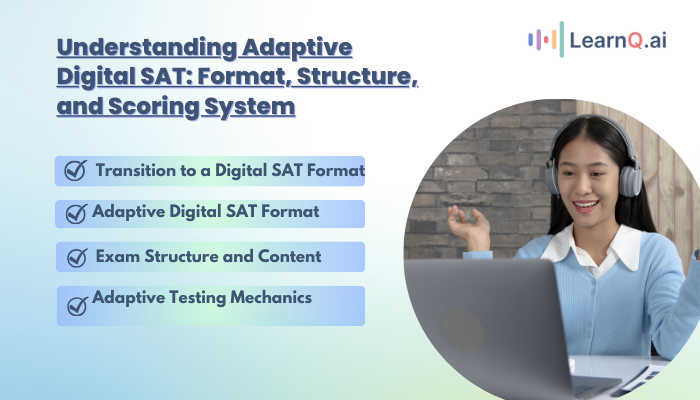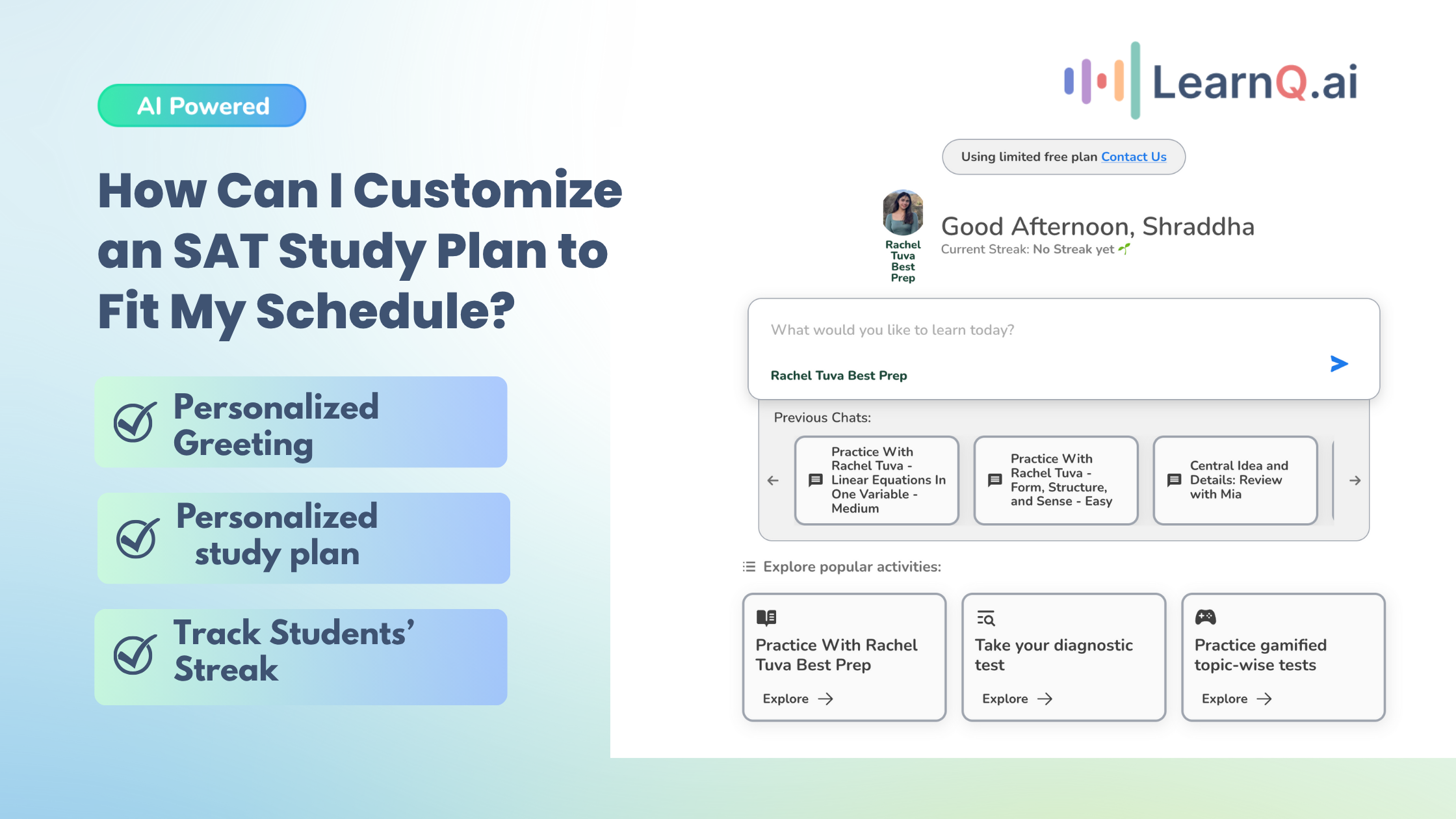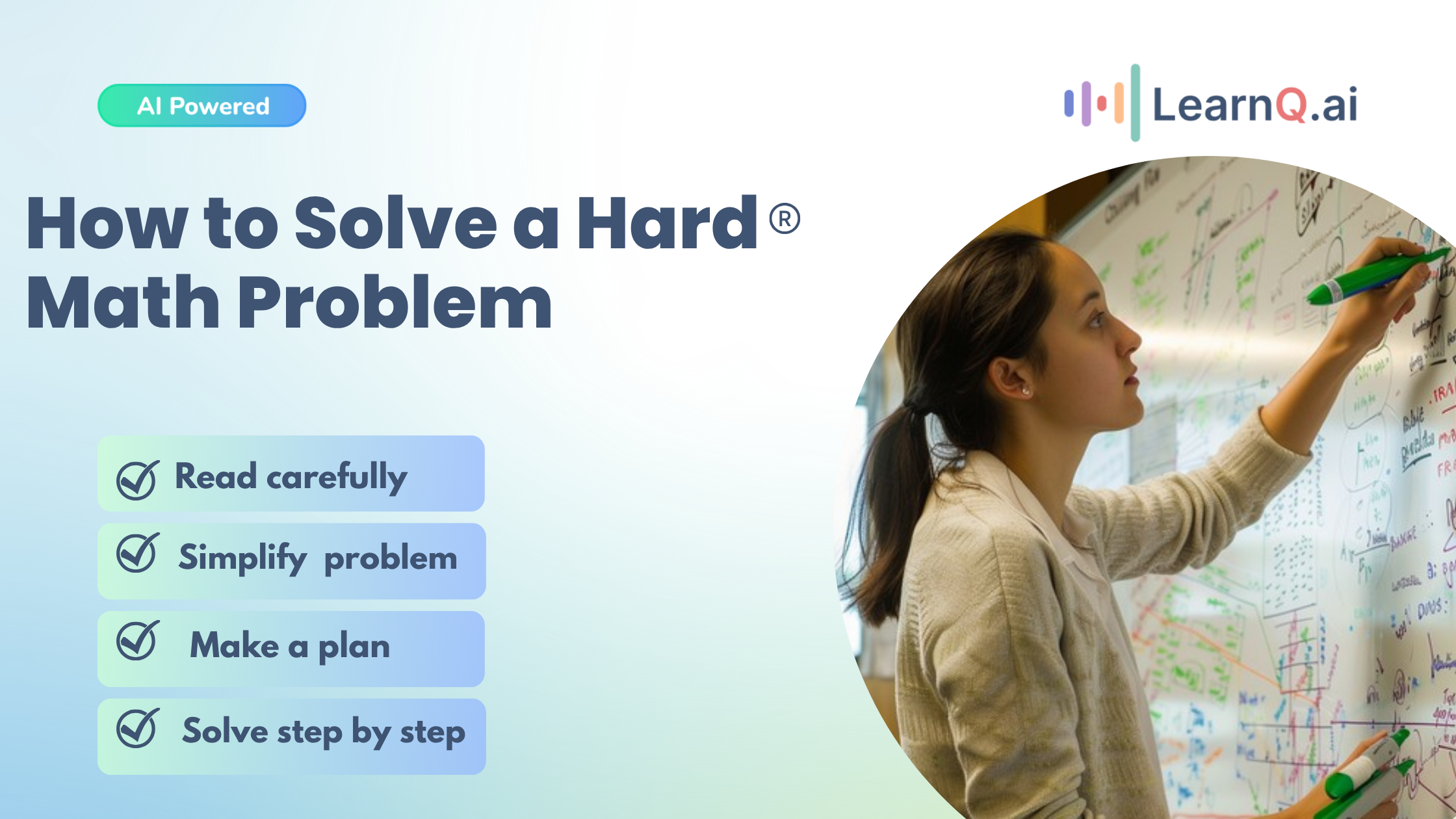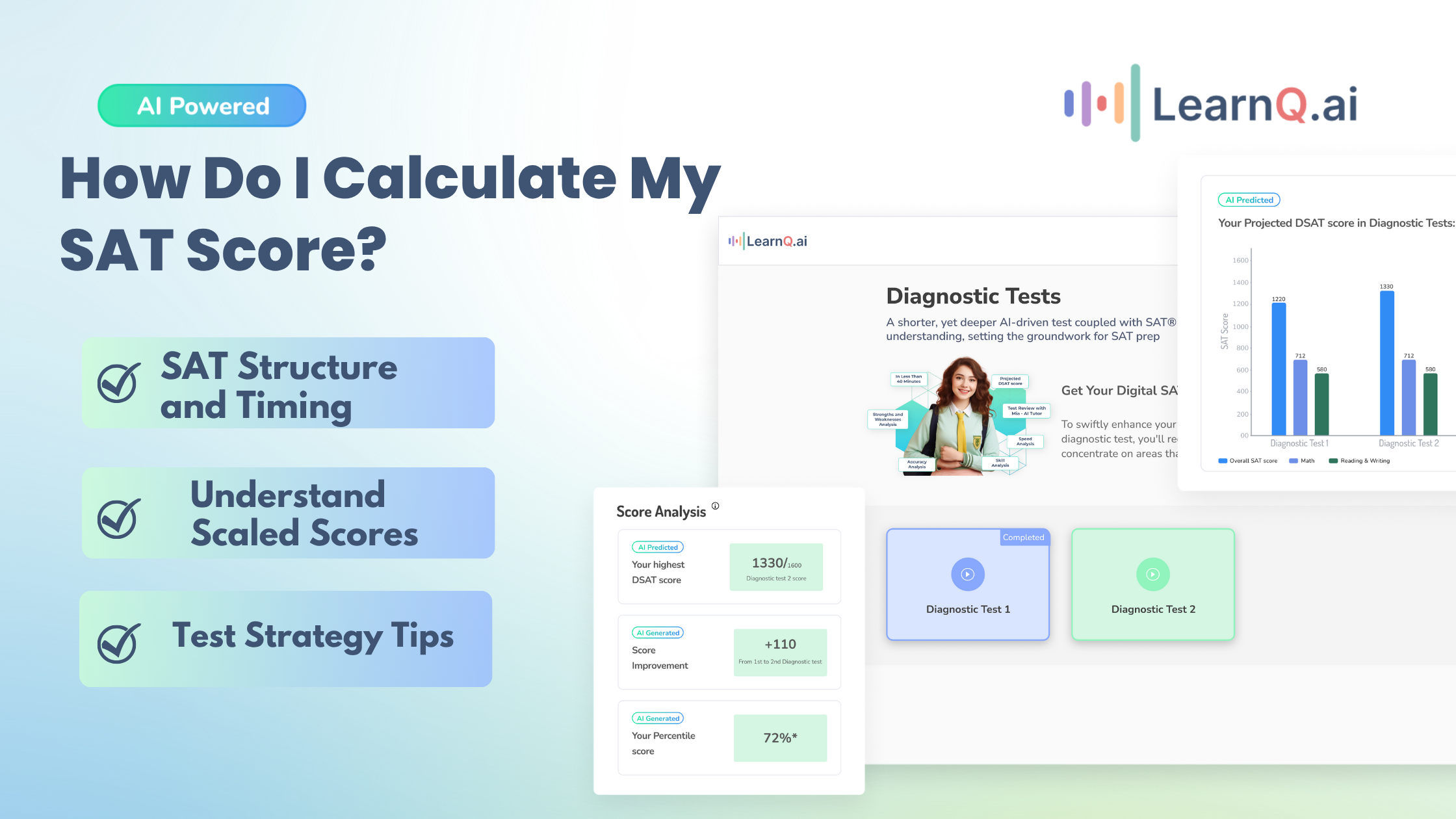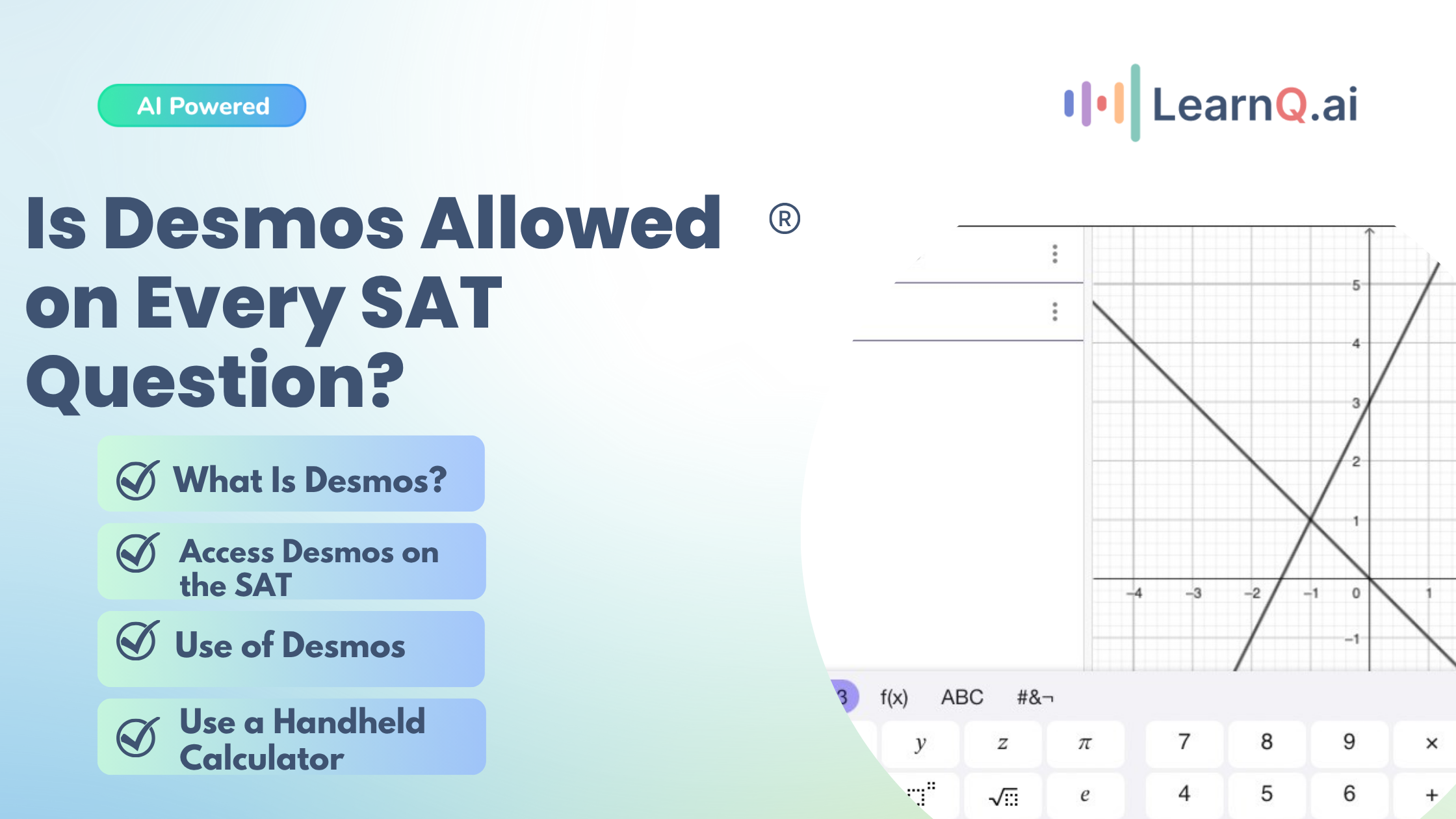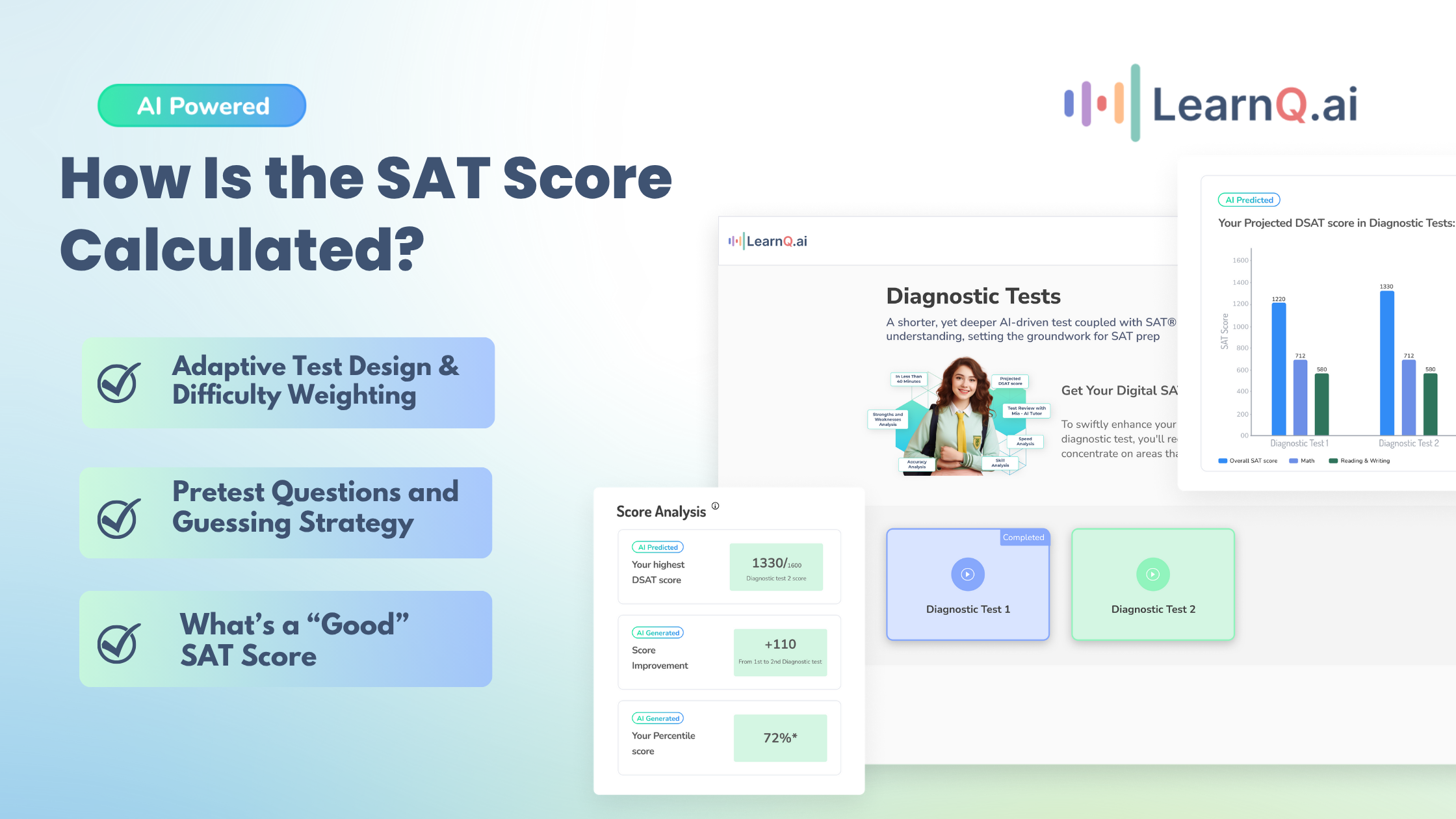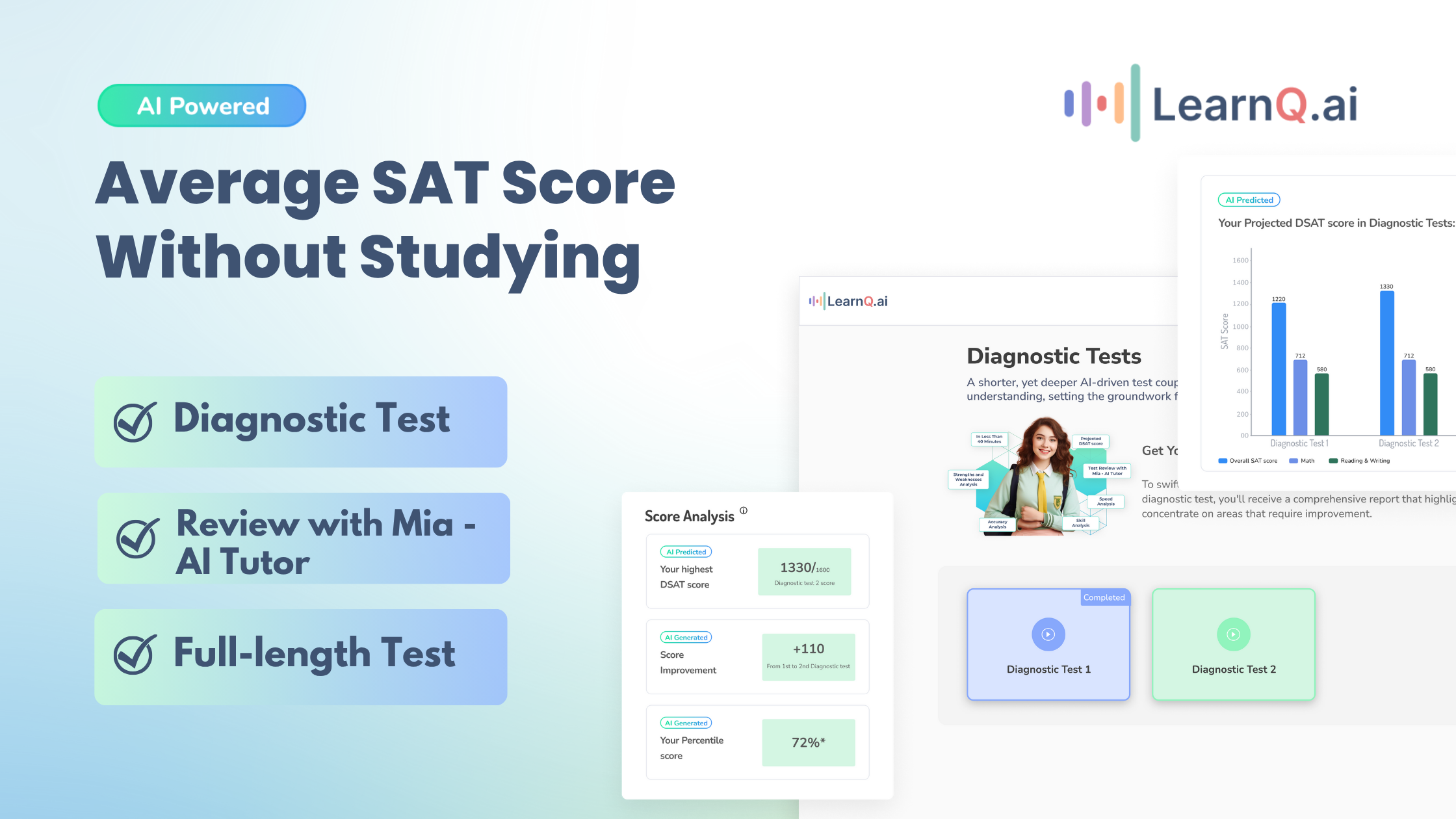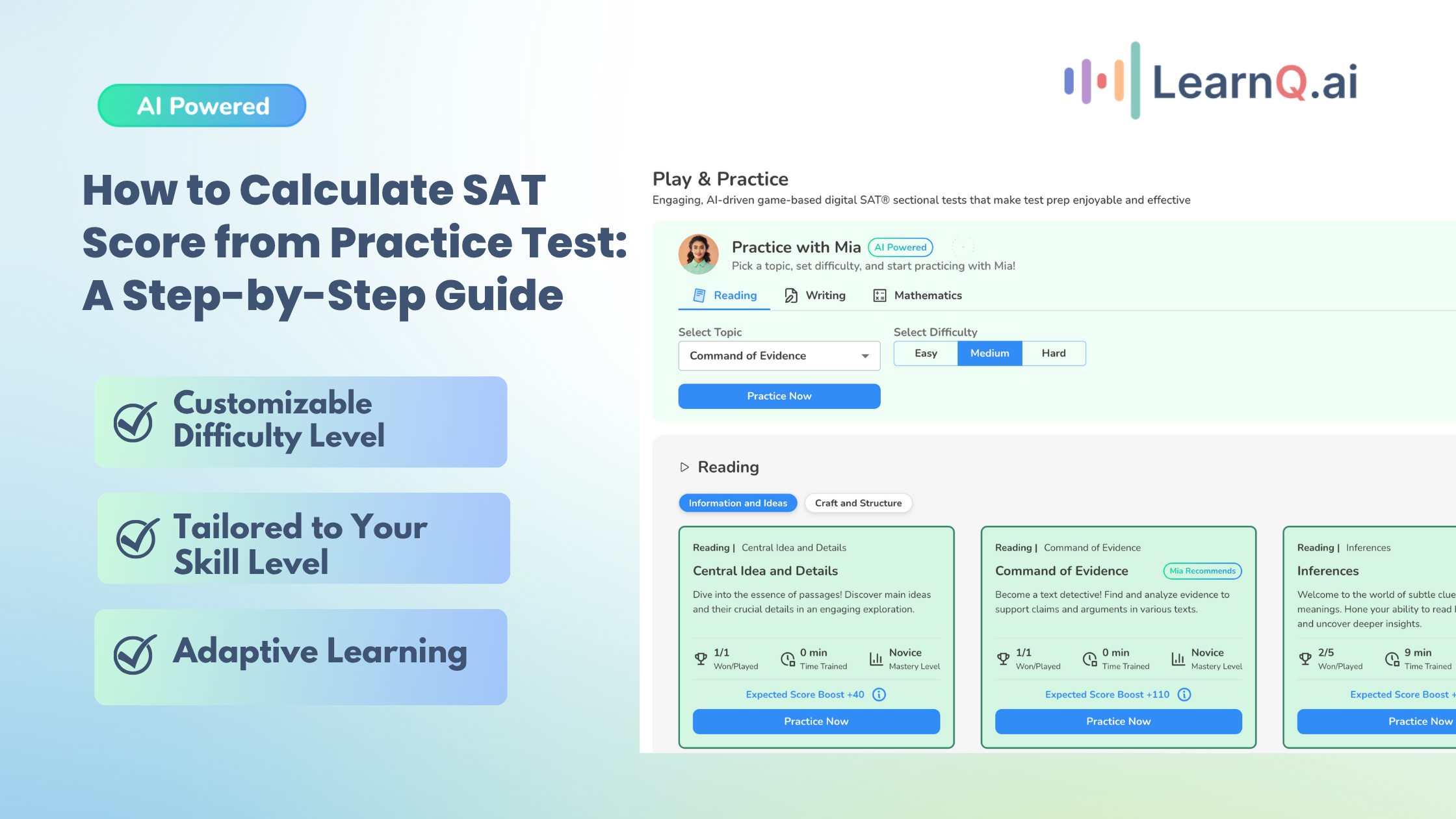Standardized testing has undergone significant changes, and the SAT is no exception. As of 2023, the SAT has transitioned to a fully adaptive digital format, making it crucial to understand how the test now works. This shift aims to make the SAT more efficient while better-assessing student abilities. Still, it can feel unfamiliar to students, parents, and teachers who use the traditional paper version.
Fun fact: when the SAT was first introduced in 1926, it had a broader focus, even including analogies in its questions. Today, the test zeroes in on math, reading, and writing skills, and with its new adaptive design, the difficulty of questions adjusts based on how you perform during the test.
LearnQ.ai is Powered by VEGA AI—Is your Institute Next?
Give students a Duolingo-style test-prep platform with Shopify-level customization for tutors and institutes.
In this article, you’ll explore how the SAT works in its latest format, covering the structure, the scoring system, and what to expect from the adaptive sections. Whether you’re a student, teacher, or parent, understanding these changes is key to navigating the SAT with confidence.
Dive in!
What is the Adaptive Digital SAT?
The Adaptive Digital SAT is the latest evolution of the SAT, transitioning from the traditional paper-based test to a fully digital, adaptive format. These college admissions tests are key components that measure skills in math, reading, and writing. The switch to the digital format began internationally in 2023, with the U.S. following in 2024.
Understanding the changes in the test format is crucial for prospective college students. The new digital SAT shifts how the test is delivered and adapts to individual student performance, ensuring a more personalized and efficient testing experience.
Key Points to Consider:
- Fully Digital Format: The SAT is now administered exclusively on digital devices provided by the student or the testing center.
- Adaptive Testing: The difficulty of questions adjusts based on your performance during the test. This allows for a shorter test while maintaining accuracy.
- Two Sections: Reading and Writing combined in one section and Math in another. Both sections are adaptive.
- Shorter Test Time: The digital SAT will be about two hours long, significantly reducing from the previous three-hour duration. This gives you a refreshed SAT test day experience.
- Score Reliability: The SAT scoring system is still based on the same 1600-point scale, and there is no need for a concordance table between the paper and digital versions.
Transition to a Digital SAT Format
This move is designed to improve security, reduce the test duration, and ensure that each student receives a unique set of questions. Adaptive testing also offers more diverse reading materials and a flexible test-taking experience.
The transition to a digital format affects all parts of the SAT Suite, including the PSAT/NMSQT and PSAT 8/9. Despite these changes, the SAT assesses the skills crucial for college and career readiness.
Key Changes:
- Test Administration: Students will take the test at a testing center or school with a proctor present. At-home testing is not an option.
- Device Accessibility: If students don’t have access to a device, the testing center will provide one on test day.
- More Diverse Content: The digital test will include more varied texts, authors, and topics that better represent test-takers’ diversity.
Why Understanding the New SAT Format Matters?
Understanding how the digital SAT works is essential for prospective college students’ preparation. The test’s adaptive nature means that strategies for success may differ from those of the traditional SAT, requiring a new approach to studying and test-taking.
Additionally, you need to be familiar with the digital tools and interface to avoid unnecessary stress on test day.
Here is a comparison of the traditional SAT vs. digital SAT.
| Feature | Traditional SAT (Paper-based) | Adaptive Digital SAT |
| Test Format | Paper-based, linear sections | Digital, adaptive |
| Duration | 3 hours | About 2 hours |
| Sections | Reading, Writing, and Math | Reading/Writing, Math |
| Adaptability | None | Adapts to performance |
| Score Scale | 1600 | 1600 |
| Test Content | Pre-determined for all | Varies by student |
| Device Requirement | None | Required (provided if needed) |
| Question Review | Can review questions anytime | Can review within modules |
Also Read: SAT Exam Feedback – November 2, 2024.
Adaptive Digital SAT Format
The Adaptive Digital SAT marks a significant shift in the way the test is delivered, moving from the traditional paper-based format to a fully digital environment. This change makes the test more efficient, secure, and personalized while keeping the same rigor and reliability.
Here’s a breakdown of how the new format works.
1. Adaptation to a Digital Environment
The most notable change with the digital SAT is the adaptive nature of the test. In a traditional paper-based exam, every student received the same set of questions.
In contrast, the adaptive digital SAT adjusts the difficulty of the questions based on a student’s performance during the test. This means that:
- Stage 1: All students start with a set of moderately difficult questions in both the reading, writing, and Math sections.
- Stage 2: Based on their performance in the first set, students will receive either a more or less challenging set of questions in the next module of the section. This adaptive approach ensures that the test is tailored to measure each student’s abilities accurately.
This method allows for a shorter overall test without compromising accuracy. The questions are selected to reflect the student’s performance, which helps maintain fairness and reliability.
2. Test Length and Section Divisions
The digital SAT is designed to be more efficient, cutting down the total test time from the traditional three hours to approximately two hours and fourteen minutes. Despite this reduction, students have more time per question, reducing the pressure during the exam.
The test is divided into two main sections:
- Reading & Writing: These have been combined into a single section in the digital SAT, unlike the traditional SAT, which separated them. This section includes questions that test comprehension, grammar, and editing skills.
- Math: The math section remains focused on key areas of algebra, problem-solving, data analysis, and some advanced math topics.
Each of these sections is divided into two modules:
- First Module: This contains a set of questions for all students which are of moderate difficulty.
- Second Module: Based on performance in the first module, students will receive either a more advanced or more basic set of questions for the second part of each section.
Enhance your Digital SAT study routine with AI-driven insights and personalized practice tests.
3. Breakdown of the Reading & Writing and Math Sections
The digital SAT assesses the same fundamental skills as the traditional test, but with an updated structure. Read on.
The Reading & Writing Section
This section combines reading comprehension and grammar into one unified part. Students will be tested on their ability to read and analyze passages, understand the author’s intent, and use evidence to support conclusions.
They will also encounter questions on standard English conventions, such as punctuation, sentence structure, and style. This section’s adaptive nature ensures that students are assessed with texts that align with their initial performance, making the test more precise.
The Math Section
The math section covers familiar topics such as algebra, problem-solving, and data analysis. It also covers some areas of advanced math, including basic trigonometry and geometry.
Like the reading section, the math questions will adapt based on student performance in the first module. If a student performs well in the initial set, the second module will include more challenging questions.
Calculators are permitted in certain parts of the math section, and the digital format will offer an on-screen calculator for convenience.
Also Read: Strategic Steps, Tips, & Templates For Effective Lesson Planning.
Exam Structure and Content
To understand how does the SAT work in its new digital format, it’s important to be familiar with the Digital SAT Structure. The test consists of two sections: Reading and Writing, and Math.
Each section is split into two equal-length modules. The first module presents a mix of easy, medium, and hard questions based on your performance. The second module adapts to either increase or decrease the difficulty level, offering a personalized testing experience.
The entire test takes 2 hours and 14 minutes to complete, with a 10-minute break between the two sections. While most questions are multiple-choice, some math problems require you to enter your answers directly. There is no penalty for guessing, so you should always attempt every question, even if you’re unsure of the answer.
Here’s a detailed breakdown of the time and content for each section.
| Component | Time Allotted | Key Features |
| Reading and Writing | 64 minutes (two 32-minute modules) | Combines reading comprehension and grammar, adapting based on student performance. |
| Math | 70 minutes (two 35-minute modules) | Includes algebra, advanced math, problem-solving, and data analysis. An on-screen calculator is available for some questions. |
| Break | 10 minutes | Occurs between the Reading and Writing, and Math sections. |
| Total | 2 hours 14 minutes | Provides more time per question compared to other tests like the ACT®, allowing students to focus more. |
By knowing how does the SAT work in this new digital and adaptive format, you can better plan your preparation strategies. This ensures you make the most of this more efficient and tailored testing approach.
Adaptive Testing Mechanics
Adaptive testing brings a new dynamic to the SAT, changing how the test adjusts to each student’s performance in real-time. Unlike the traditional SAT, where every student receives the same set of questions, the digital SAT personalizes the test for each individual, creating a more tailored assessment experience.
This new approach aims to provide a more accurate measure of a student’s abilities while reducing unnecessary stress from overly difficult or overly easy questions.
How Adaptive Testing Works?
The digital SAT is divided into modules. The first module in both the Reading, Writing, and Math sections presents a standard mix of easy, medium, and hard questions to all test-takers.
The second module adjusts accordingly based on how you perform in this initial set.
- Strong Performance: If you perform well, the second module will include more challenging questions to assess your skill level further.
- Weaker Performance: If you struggle with the first module, the second module will adapt by offering slightly easier questions, keeping the difficulty more in line with your abilities.
This system ensures that the test is neither easy nor hard for any individual, making the overall experience more balanced and less frustrating.
Impact on Pacing and Strategies
The adaptive nature of the digital SAT has a significant impact on how students should approach pacing and their overall test-taking strategy. Since the difficulty of the second module depends on performance in the first, it’s important to approach the test with care:
- Pacing: Compared to other standardized tests like the ACT®, you may have more time per question, but it’s still essential to manage time wisely. Rushing through the first module could lead to mistakes, affecting the difficulty level of the second module. This could potentially lower your overall score.
- Strategic Guessing: Because there is no penalty for guessing, it’s better to attempt every question, even if you’re unsure. Answering more questions in the first module increases the likelihood of seeing more challenging questions in the second. This could lead to a higher score.
- Balanced Approach: Adaptive testing rewards consistent performance, so instead of focusing on finishing the section quickly, aim for accuracy. A thoughtful and balanced approach in the first module can ensure that the second module matches your true skill level.
Scoring System of the Adaptive Digital SAT
The scoring system for the Adaptive Digital SAT remains consistent with the traditional SAT, with a total score ranging from 400 to 1600. This score is a combination of the results from the two main sections: Reading and Writing, and Math.
Each section is scored on a scale of 200 to 800, which reflects a student’s proficiency in the respective areas.
Total Score: 400–1600
The overall SAT score is the sum of the section scores, with a range from 400 (the lowest possible combined score) to 1600 (the highest possible). Colleges use this total score to gauge a student’s readiness for academic success.
Section Scores: 200–800 for Reading & Writing and Math
The two sections—reading, writing, and Math—are each scored independently on a scale from 200 to 800.
These scores offer a more detailed breakdown of a student’s performance in both language-related and mathematical areas. Although the test adapts to question difficulty, the final section scores accurately reflect a student’s abilities, just like the traditional paper-based SAT.
SAT Test Administration and Logistics
As the SAT transitions to a fully digital format, it’s important to be aware of the changes in test administration and logistics. This new format introduces flexibility and convenience for students while maintaining the same rigorous standards.
- Devices: Students can take the digital SAT on various devices, including personal laptops, school-owned devices, and Chromebooks. A custom-built testing application will be required for all test-takers.
- Internet and Battery Life: While internet connectivity is needed to begin and submit the test, the application is designed to withstand connection outages. Students should ensure their device is fully charged, as limited power outlets may be available at test centers.
- Digital Testing Tools: The testing app includes several helpful tools, such as a timer, a built-in calculator for math sections, reference sheets, and the ability to mark questions for review.
- Borrowing Devices: Students without access to a compatible device can request to borrow one from the College Board when registering for the SAT.
- Accommodations and Supports: Special accommodations for students with disabilities will continue, including extended time and assistive technologies. English learners will have access to translated directions and bilingual dictionaries.
Preparing for the Adaptive Digital SAT
With the SAT’s shift to a digital and adaptive format, it’s essential to adjust your study strategies to match the new testing environment.
Success comes from mastering digital tools, adaptive testing mechanics, and using the right study resources for the format.
1. Adapting Study Strategies for the Digital Format
The adaptive nature of the digital SAT requires a different approach to preparation. Focus on improving accuracy rather than rushing through questions, as the test adjusts difficulty based on your performance. Practice pacing yourself, and get used to navigating between questions within timed modules.
2. Using High-Quality Digital Study Materials
Switching to digital study tools is crucial for mimicking the actual test experience. Use digital SAT prep materials that mirror the test’s adaptive nature, including practice questions that reflect the same format and difficulty levels as the real test. Interactive learning platforms can help you adapt to the digital environment.
3. Importance of Practice Exams
Taking full-length practice exams is one of the most effective ways to prepare for the digital SAT. These exams help you grasp adaptive testing and adjust your strategies as you transition between modules.
Familiarity with the digital interface and tools, such as the on-screen calculator and timer, will also help you feel more comfortable on test day.
Also Read: Tips for Solving Problems on SAT Practice Test With Study Plan.
Enhance your Digital SAT study routine with AI-driven insights and personalized practice tests.
4. Preparing for Digital SAT with LearnQ
Whether you’re just starting your preparation or fine-tuning your skills, LearnQ has everything you need to succeed. Here’s how LearnQ can support your Digital SAT journey.
- Free Diagnostic Test: Assess your current skills and create a customized study plan. LearnQ’s diagnostic tests predict your SAT score and guide you in developing an effective study strategy.
- Practice and Play: Engage with LearnQ’s SAT Practice Tests and DSAT Practice Tests for 2024. Experience a gamified, adaptive learning environment with over 10,000 new Digital SAT questions based on the College Board’s latest pattern.
- Full-Length Tests: Challenge yourself with full-length SAT and DSAT practice exams. LearnQ provides digital SAT questions and resources, including access to Bluebook DSAT Test 2024, for a realistic testing experience.
- AI Tutor: LearnQ’s AI Tutor, Mia, offers personalized learning support. Whether you need help with Math or prefer tailored guidance, Mia adapts to your learning pace and style to ensure a focused study approach.
LearnQ.ai is powered by VEGA AI—Is your institute next?
Offer students a Duolingo-style test-prep platform with Shopify-level customization for tutors and institutes.






Conclusion
In this article, you’ve learned the key points for preparing for the Adaptive Digital SAT. You explored how to adapt your study strategies, understand the test format, and practice effectively using full-length exams. Your success will come from mastering the digital tools and familiarizing yourself with adaptive testing.
As you prepare, approach the SAT with confidence. With LearnQ, you have access to diagnostic tests, full-length practice exams, and personalized AI tutoring to help you feel fully prepared on test day.
Ready to ace the SAT? Join LearnQ now and get the resources you need to excel. Also, connect with other students in our Discord community for support, tips, and motivation as you prepare for your test.

